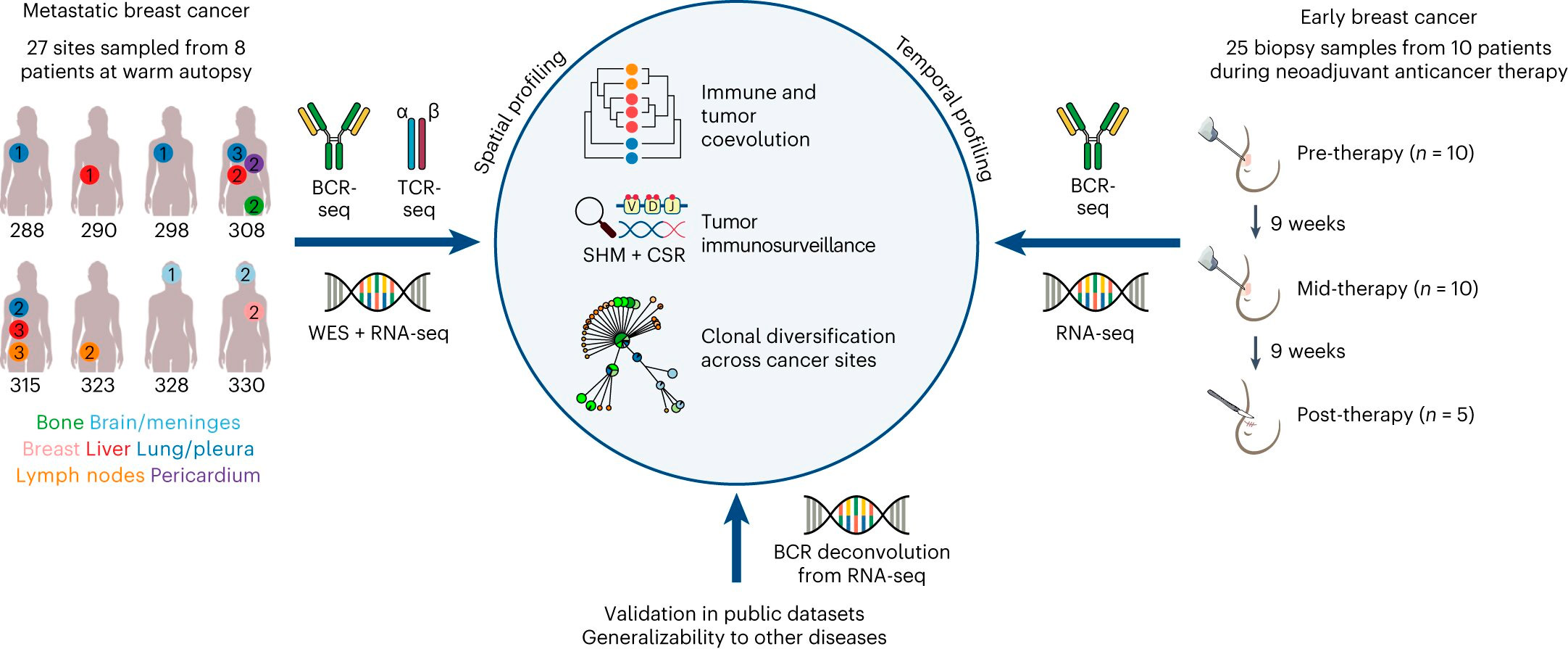Nye publikasjoner
Forskere oppdager hvordan B-celler oppdager kreft i kroppen
Sist anmeldt: 02.07.2025

Alt iLive-innhold blir gjennomgått med medisin eller faktisk kontrollert for å sikre så mye faktuell nøyaktighet som mulig.
Vi har strenge retningslinjer for innkjøp og kun kobling til anerkjente medieområder, akademiske forskningsinstitusjoner og, når det er mulig, medisinsk peer-evaluerte studier. Merk at tallene i parenteser ([1], [2], etc.) er klikkbare koblinger til disse studiene.
Hvis du føler at noe av innholdet vårt er unøyaktig, utdatert eller ellers tvilsomt, velg det og trykk Ctrl + Enter.

Forskere har oppdaget viktige trekk ved immune B-celler som gjør dem vellykkede i bekjempelsen av svulster, inkludert tilfeller der kreften har spredt seg til andre deler av kroppen.
I tidsskriftet Nature Immunology beskriver forskerne utviklingen av et beregningsverktøy for å identifisere disse kreftbekjempende immuncellene, noe som kan føre til bedre personlige immunterapier. For tiden fungerer de fleste immunterapier bare for et mindretall av pasientene, og forskere jobber hardt med å utvide gruppen av pasienter som kan dra nytte av dem.
Forskere fra Institutt for biokjemi ved University of Oxford, Institute of Cancer Research London og University of Cambridge tok biopsier fra brystkreftpasienter og brukte en teknikk kalt B-cellereseptorsekvensering for å identifisere genetiske variasjoner i B-celler.
B-celler, i likhet med de mer kjente T-cellene, er en del av immunforsvaret og hjelper kroppen med å bekjempe infeksjoner og kreft. De produserer proteiner kalt antistoffer som fester seg til skadelige stoffer som virus og kreft, og rekrutterer andre deler av immunforsvaret for å ødelegge dem. Når en reseptor på en B-celle gjenkjenner og binder seg til en kreftcelle, gjennomgår B-cellen endringer og blir enda mer effektiv til å målrette disse kreftcellene.
Førsteamanuensis Rachel Bashford-Rogers, hovedforfatter av studien og førsteamanuensis ved Institutt for biokjemi ved Universitetet i Oxford, sa: «Ved å bruke en kombinasjon av forskjellige genetiske teknikker viste vi at både B-celle- og T-celle-immunresponser utvikler seg i takt med endringer som skjer på individuelle tumorsteder i kroppen. Imidlertid ble noen B-celleresponser observert på tvers av mange eller alle tumorsteder, noe som tyder på at de søker etter kreftceller på forskjellige steder.»
«Her har vi identifisert et vanlig og forutsigbart mønster for immunovervåking av celler på tvers av flere tumorsteder og utviklet et verktøy for å identifisere disse cellene nøyaktig. Vi viser at dette også gjelder andre sykdommer, inkludert autoimmune tilstander, og dermed legger dette arbeidet grunnlaget for å prioritere spesifikke antistoffer for behandling av kreft og andre sykdommer.»
Forskerne fant at noen unike B-celler som endret sin genetiske sekvens etter å ha gjenkjent og målrettet kreftceller, var tilstede på flere metastatiske tumorsteder der kreften hadde spredt seg. Dette betyr at etter å ha gjenkjent kreft i ett område av kroppen, migrerer B-celler for å jakte på kreft i forskjellige deler av kroppen. B-celler som ble funnet på bare ett tumorsted, hadde mindre sannsynlighet for å endre sekvensen sin og utførte ikke effektiv kreftovervåking.
Teamet fant også ut at B-cellene som var tilstede gjennom hele pasientenes behandling var de som gjenkjente kreften og endret sin genetiske sekvens, og dermed ble mer effektive til å gjenkjenne kreft.
Forskerne brukte denne informasjonen til å utvikle et beregningsverktøy som forutsier hvilke B-celler som mest sannsynlig vil oppdage og målrette kreftceller.
De tror at deres prediktive verktøy kan brukes til å identifisere de mest effektive antikreft-B-cellene hos en pasient og kunstig konstruere antistoffene disse B-cellene produserer naturlig. Dette kan brukes som en personlig immunterapi som styrker pasientens immunsystem.
Dr. Stephen-John Sammut, førsteforfatter av studien og leder av Cancer Dynamics Group ved Institute of Cancer Research i London og onkologkonsulent ved Royal Marsden Hospital NHS Foundation Trust, sa: «Når kreft sprer seg til andre deler av kroppen, er det ofte mye vanskeligere å behandle. Studien vår har vist at immunresponsen mot kreft ikke er begrenset til hvor svulsten først dukker opp – hvis en immun B-celle klarer å oppdage kreft i én del av kroppen, vil den søke etter lignende kreftceller i andre deler av kroppen.»
«Det finnes for tiden svært få immunterapier som kan brukes til å behandle brystkreft. Beregningsverktøyet vi har utviklet vil gjøre det mulig for oss å isolere og identifisere B-cellene som har gjenkjent kreftcellene, samt antistoffene de produserer. Dette vil gjøre det mulig for oss å utvikle antikreftantistoffer som ligner på de som produseres av B-celler, som deretter kan brukes som en personlig behandling for å styrke immunresponsen mot avansert brystkreft.»

Beskrivelse av brystkreftkohorter og oversikt over studiedesign. Kilde: Nature Immunology (2024). DOI: 10.1038/s41590-024-01821-0
Professor Christian Helin, generaldirektør ved Institute of Cancer Research i London, la til: «Immunterapier har endret utsiktene for mange forskjellige typer kreft, men dessverre fungerer de fortsatt bare for et mindretall av pasientene. Vi må bedre forstå hvordan immunforsvaret beskytter kroppen mot kreft, og mesteparten av forskningen så langt har fokusert på T-cellenes rolle – CAR T-celleterapi er den mest kjente behandlingen som har kommet ut av denne forskningen.»
«Denne studien gir spennende innsikt i B-cellenes rolle under kreftvekst og -spredning, og jeg ser frem til å se dette verktøyet brukt til å fokusere innsatsen på å utvikle personlige kreftimmunterapier som kan fungere for mange flere mennesker enn de fleste eksisterende immunterapier.»
